Executive Summary: Comparing PMBoK and Agile Project Management
VerifiedAdded on 2023/02/02
|12
|2689
|91
Report
AI Summary
This report provides an executive summary comparing the PMBoK and Agile frameworks for project management. It begins by defining project management and its key phases, including initiation, planning, execution, monitoring, and closing. The report then analyzes the PMBoK method, emphasizing its process-oriented approach, standardization, and risk minimization through defined phases. It contrasts this with the Agile approach, highlighting its iterative nature, continuous feedback, and focus on adaptability, particularly in software development. The comparison includes a detailed table outlining the differences in scope, time, cost, quality, and risk management between the two methodologies. The report also discusses the practical applicability of each method, suggesting PMBoK for technology implementations and Agile for software projects. The conclusion summarizes the key takeaways, emphasizing the strengths and weaknesses of each framework and their suitability for different project contexts.

PROJECT MANAGEMENT
Paraphrase This Document
Need a fresh take? Get an instant paraphrase of this document with our AI Paraphraser
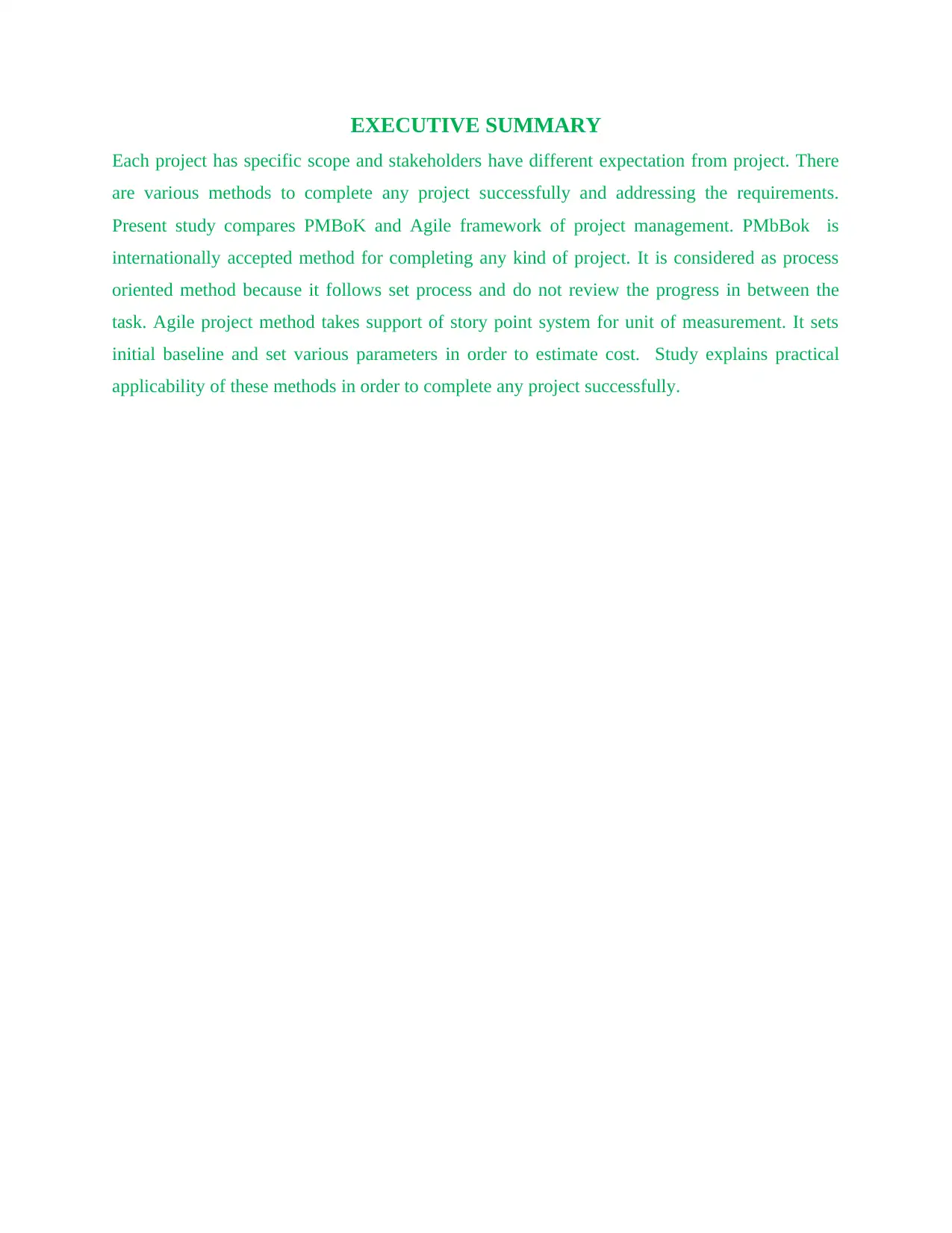
EXECUTIVE SUMMARY
Each project has specific scope and stakeholders have different expectation from project. There
are various methods to complete any project successfully and addressing the requirements.
Present study compares PMBoK and Agile framework of project management. PMbBok is
internationally accepted method for completing any kind of project. It is considered as process
oriented method because it follows set process and do not review the progress in between the
task. Agile project method takes support of story point system for unit of measurement. It sets
initial baseline and set various parameters in order to estimate cost. Study explains practical
applicability of these methods in order to complete any project successfully.
Each project has specific scope and stakeholders have different expectation from project. There
are various methods to complete any project successfully and addressing the requirements.
Present study compares PMBoK and Agile framework of project management. PMbBok is
internationally accepted method for completing any kind of project. It is considered as process
oriented method because it follows set process and do not review the progress in between the
task. Agile project method takes support of story point system for unit of measurement. It sets
initial baseline and set various parameters in order to estimate cost. Study explains practical
applicability of these methods in order to complete any project successfully.
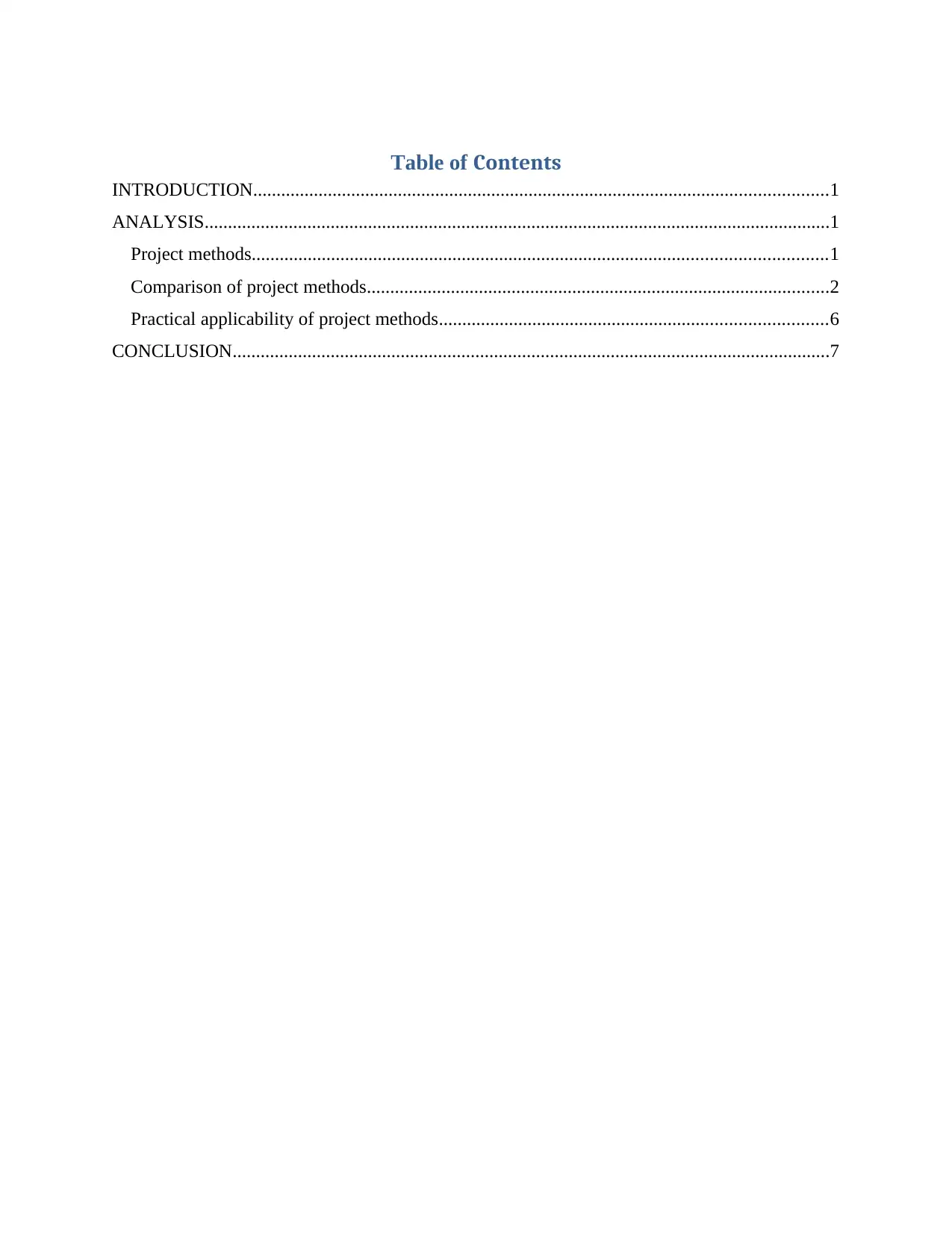
Table of Contents
INTRODUCTION...........................................................................................................................1
ANALYSIS......................................................................................................................................1
Project methods...........................................................................................................................1
Comparison of project methods...................................................................................................2
Practical applicability of project methods...................................................................................6
CONCLUSION................................................................................................................................7
INTRODUCTION...........................................................................................................................1
ANALYSIS......................................................................................................................................1
Project methods...........................................................................................................................1
Comparison of project methods...................................................................................................2
Practical applicability of project methods...................................................................................6
CONCLUSION................................................................................................................................7
⊘ This is a preview!⊘
Do you want full access?
Subscribe today to unlock all pages.

Trusted by 1+ million students worldwide
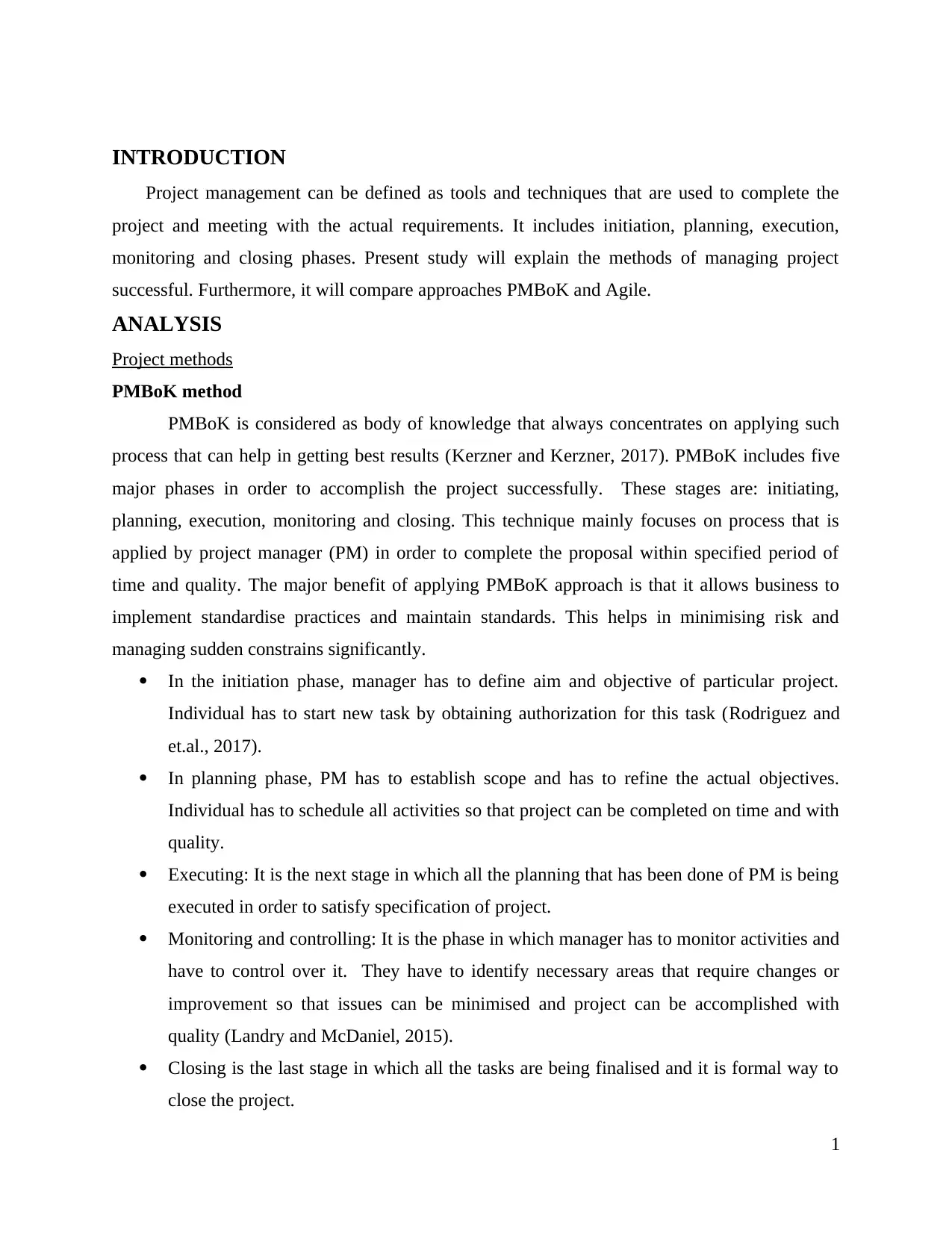
INTRODUCTION
Project management can be defined as tools and techniques that are used to complete the
project and meeting with the actual requirements. It includes initiation, planning, execution,
monitoring and closing phases. Present study will explain the methods of managing project
successful. Furthermore, it will compare approaches PMBoK and Agile.
ANALYSIS
Project methods
PMBoK method
PMBoK is considered as body of knowledge that always concentrates on applying such
process that can help in getting best results (Kerzner and Kerzner, 2017). PMBoK includes five
major phases in order to accomplish the project successfully. These stages are: initiating,
planning, execution, monitoring and closing. This technique mainly focuses on process that is
applied by project manager (PM) in order to complete the proposal within specified period of
time and quality. The major benefit of applying PMBoK approach is that it allows business to
implement standardise practices and maintain standards. This helps in minimising risk and
managing sudden constrains significantly.
In the initiation phase, manager has to define aim and objective of particular project.
Individual has to start new task by obtaining authorization for this task (Rodriguez and
et.al., 2017).
In planning phase, PM has to establish scope and has to refine the actual objectives.
Individual has to schedule all activities so that project can be completed on time and with
quality.
Executing: It is the next stage in which all the planning that has been done of PM is being
executed in order to satisfy specification of project.
Monitoring and controlling: It is the phase in which manager has to monitor activities and
have to control over it. They have to identify necessary areas that require changes or
improvement so that issues can be minimised and project can be accomplished with
quality (Landry and McDaniel, 2015).
Closing is the last stage in which all the tasks are being finalised and it is formal way to
close the project.
1
Project management can be defined as tools and techniques that are used to complete the
project and meeting with the actual requirements. It includes initiation, planning, execution,
monitoring and closing phases. Present study will explain the methods of managing project
successful. Furthermore, it will compare approaches PMBoK and Agile.
ANALYSIS
Project methods
PMBoK method
PMBoK is considered as body of knowledge that always concentrates on applying such
process that can help in getting best results (Kerzner and Kerzner, 2017). PMBoK includes five
major phases in order to accomplish the project successfully. These stages are: initiating,
planning, execution, monitoring and closing. This technique mainly focuses on process that is
applied by project manager (PM) in order to complete the proposal within specified period of
time and quality. The major benefit of applying PMBoK approach is that it allows business to
implement standardise practices and maintain standards. This helps in minimising risk and
managing sudden constrains significantly.
In the initiation phase, manager has to define aim and objective of particular project.
Individual has to start new task by obtaining authorization for this task (Rodriguez and
et.al., 2017).
In planning phase, PM has to establish scope and has to refine the actual objectives.
Individual has to schedule all activities so that project can be completed on time and with
quality.
Executing: It is the next stage in which all the planning that has been done of PM is being
executed in order to satisfy specification of project.
Monitoring and controlling: It is the phase in which manager has to monitor activities and
have to control over it. They have to identify necessary areas that require changes or
improvement so that issues can be minimised and project can be accomplished with
quality (Landry and McDaniel, 2015).
Closing is the last stage in which all the tasks are being finalised and it is formal way to
close the project.
1
Paraphrase This Document
Need a fresh take? Get an instant paraphrase of this document with our AI Paraphraser
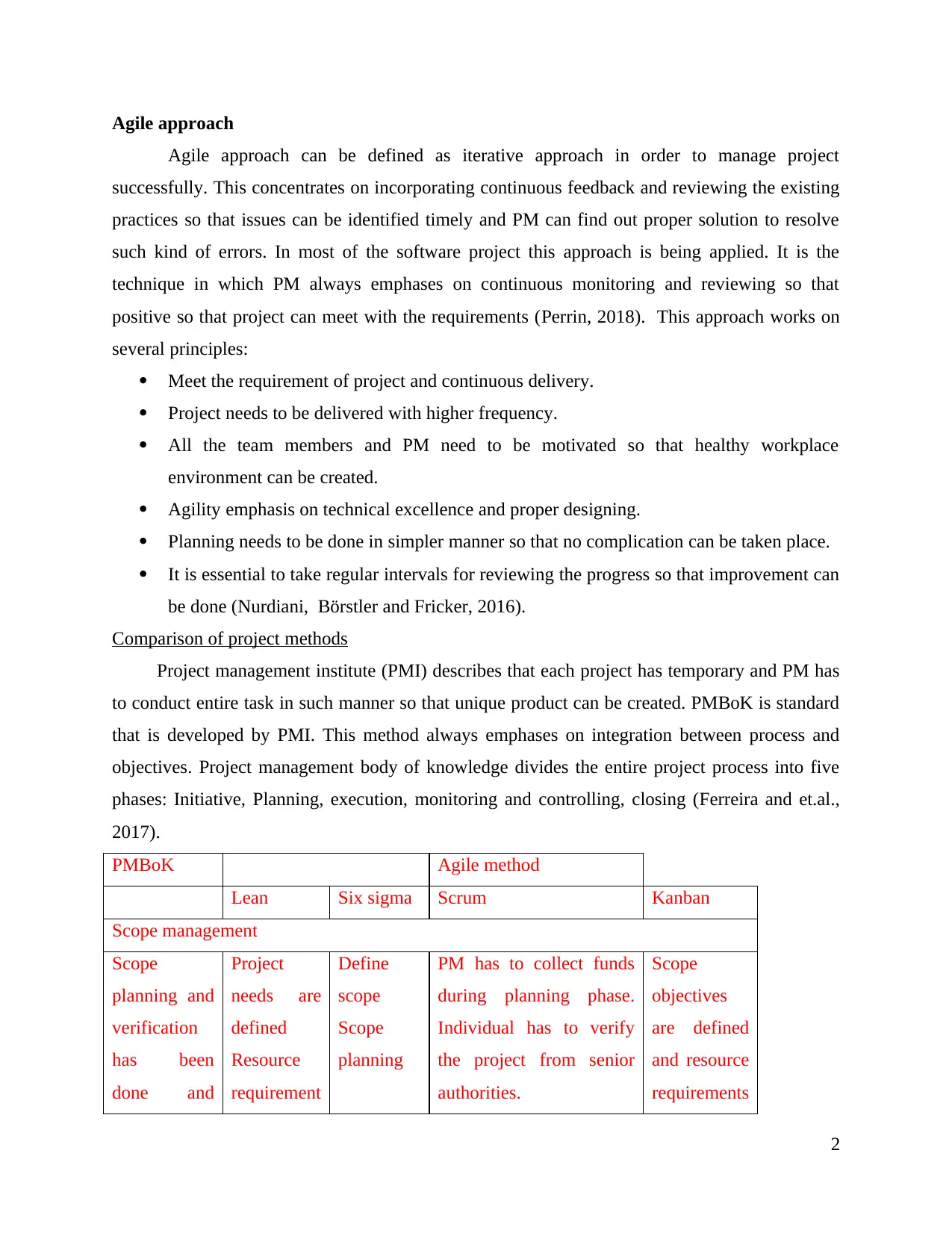
Agile approach
Agile approach can be defined as iterative approach in order to manage project
successfully. This concentrates on incorporating continuous feedback and reviewing the existing
practices so that issues can be identified timely and PM can find out proper solution to resolve
such kind of errors. In most of the software project this approach is being applied. It is the
technique in which PM always emphases on continuous monitoring and reviewing so that
positive so that project can meet with the requirements (Perrin, 2018). This approach works on
several principles:
Meet the requirement of project and continuous delivery.
Project needs to be delivered with higher frequency.
All the team members and PM need to be motivated so that healthy workplace
environment can be created.
Agility emphasis on technical excellence and proper designing.
Planning needs to be done in simpler manner so that no complication can be taken place.
It is essential to take regular intervals for reviewing the progress so that improvement can
be done (Nurdiani, Börstler and Fricker, 2016).
Comparison of project methods
Project management institute (PMI) describes that each project has temporary and PM has
to conduct entire task in such manner so that unique product can be created. PMBoK is standard
that is developed by PMI. This method always emphases on integration between process and
objectives. Project management body of knowledge divides the entire project process into five
phases: Initiative, Planning, execution, monitoring and controlling, closing (Ferreira and et.al.,
2017).
PMBoK Agile method
Lean Six sigma Scrum Kanban
Scope management
Scope
planning and
verification
has been
done and
Project
needs are
defined
Resource
requirement
Define
scope
Scope
planning
PM has to collect funds
during planning phase.
Individual has to verify
the project from senior
authorities.
Scope
objectives
are defined
and resource
requirements
2
Agile approach can be defined as iterative approach in order to manage project
successfully. This concentrates on incorporating continuous feedback and reviewing the existing
practices so that issues can be identified timely and PM can find out proper solution to resolve
such kind of errors. In most of the software project this approach is being applied. It is the
technique in which PM always emphases on continuous monitoring and reviewing so that
positive so that project can meet with the requirements (Perrin, 2018). This approach works on
several principles:
Meet the requirement of project and continuous delivery.
Project needs to be delivered with higher frequency.
All the team members and PM need to be motivated so that healthy workplace
environment can be created.
Agility emphasis on technical excellence and proper designing.
Planning needs to be done in simpler manner so that no complication can be taken place.
It is essential to take regular intervals for reviewing the progress so that improvement can
be done (Nurdiani, Börstler and Fricker, 2016).
Comparison of project methods
Project management institute (PMI) describes that each project has temporary and PM has
to conduct entire task in such manner so that unique product can be created. PMBoK is standard
that is developed by PMI. This method always emphases on integration between process and
objectives. Project management body of knowledge divides the entire project process into five
phases: Initiative, Planning, execution, monitoring and controlling, closing (Ferreira and et.al.,
2017).
PMBoK Agile method
Lean Six sigma Scrum Kanban
Scope management
Scope
planning and
verification
has been
done and
Project
needs are
defined
Resource
requirement
Define
scope
Scope
planning
PM has to collect funds
during planning phase.
Individual has to verify
the project from senior
authorities.
Scope
objectives
are defined
and resource
requirements
2
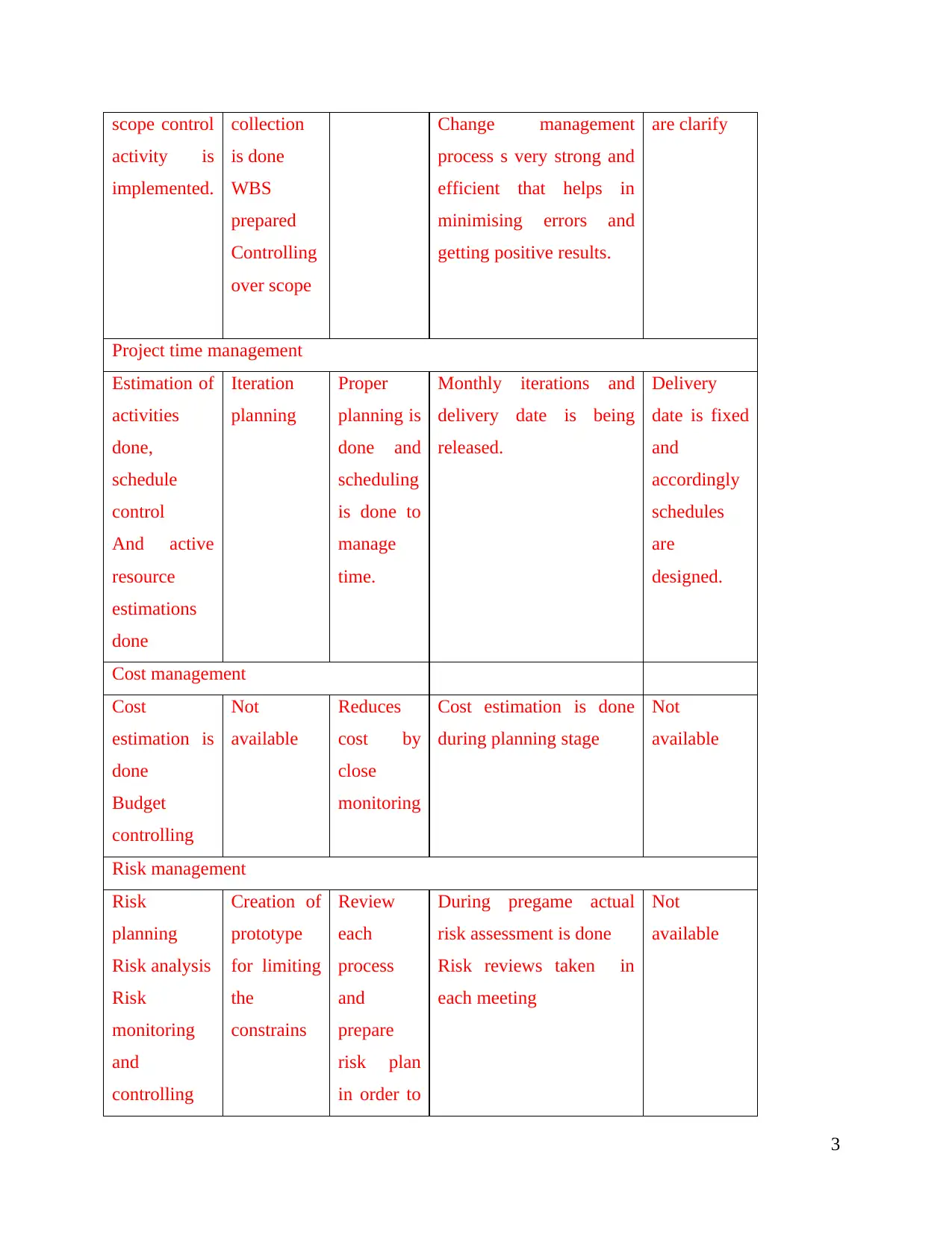
scope control
activity is
implemented.
collection
is done
WBS
prepared
Controlling
over scope
Change management
process s very strong and
efficient that helps in
minimising errors and
getting positive results.
are clarify
Project time management
Estimation of
activities
done,
schedule
control
And active
resource
estimations
done
Iteration
planning
Proper
planning is
done and
scheduling
is done to
manage
time.
Monthly iterations and
delivery date is being
released.
Delivery
date is fixed
and
accordingly
schedules
are
designed.
Cost management
Cost
estimation is
done
Budget
controlling
Not
available
Reduces
cost by
close
monitoring
Cost estimation is done
during planning stage
Not
available
Risk management
Risk
planning
Risk analysis
Risk
monitoring
and
controlling
Creation of
prototype
for limiting
the
constrains
Review
each
process
and
prepare
risk plan
in order to
During pregame actual
risk assessment is done
Risk reviews taken in
each meeting
Not
available
3
activity is
implemented.
collection
is done
WBS
prepared
Controlling
over scope
Change management
process s very strong and
efficient that helps in
minimising errors and
getting positive results.
are clarify
Project time management
Estimation of
activities
done,
schedule
control
And active
resource
estimations
done
Iteration
planning
Proper
planning is
done and
scheduling
is done to
manage
time.
Monthly iterations and
delivery date is being
released.
Delivery
date is fixed
and
accordingly
schedules
are
designed.
Cost management
Cost
estimation is
done
Budget
controlling
Not
available
Reduces
cost by
close
monitoring
Cost estimation is done
during planning stage
Not
available
Risk management
Risk
planning
Risk analysis
Risk
monitoring
and
controlling
Creation of
prototype
for limiting
the
constrains
Review
each
process
and
prepare
risk plan
in order to
During pregame actual
risk assessment is done
Risk reviews taken in
each meeting
Not
available
3
⊘ This is a preview!⊘
Do you want full access?
Subscribe today to unlock all pages.

Trusted by 1+ million students worldwide
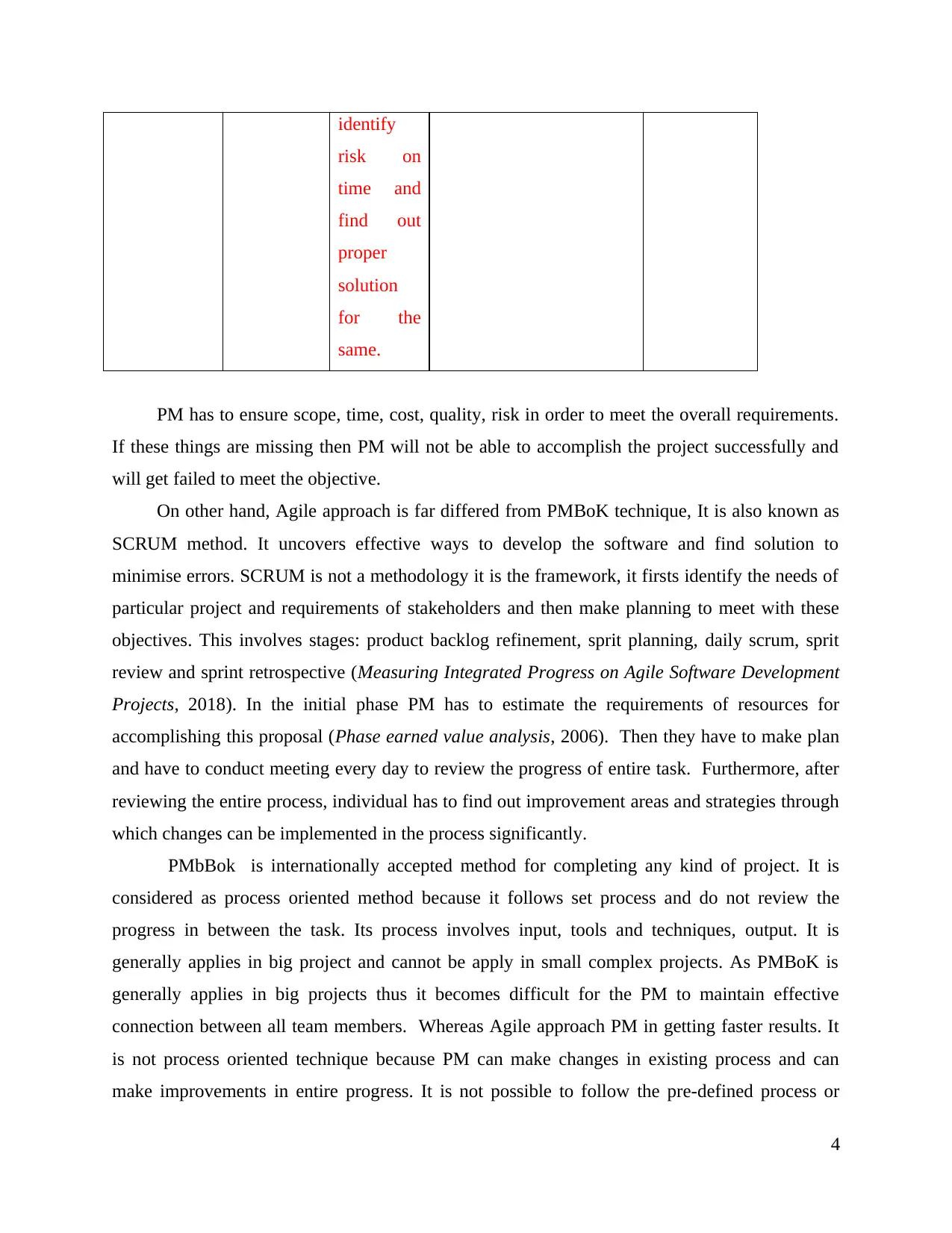
identify
risk on
time and
find out
proper
solution
for the
same.
PM has to ensure scope, time, cost, quality, risk in order to meet the overall requirements.
If these things are missing then PM will not be able to accomplish the project successfully and
will get failed to meet the objective.
On other hand, Agile approach is far differed from PMBoK technique, It is also known as
SCRUM method. It uncovers effective ways to develop the software and find solution to
minimise errors. SCRUM is not a methodology it is the framework, it firsts identify the needs of
particular project and requirements of stakeholders and then make planning to meet with these
objectives. This involves stages: product backlog refinement, sprit planning, daily scrum, sprit
review and sprint retrospective (Measuring Integrated Progress on Agile Software Development
Projects, 2018). In the initial phase PM has to estimate the requirements of resources for
accomplishing this proposal (Phase earned value analysis, 2006). Then they have to make plan
and have to conduct meeting every day to review the progress of entire task. Furthermore, after
reviewing the entire process, individual has to find out improvement areas and strategies through
which changes can be implemented in the process significantly.
PMbBok is internationally accepted method for completing any kind of project. It is
considered as process oriented method because it follows set process and do not review the
progress in between the task. Its process involves input, tools and techniques, output. It is
generally applies in big project and cannot be apply in small complex projects. As PMBoK is
generally applies in big projects thus it becomes difficult for the PM to maintain effective
connection between all team members. Whereas Agile approach PM in getting faster results. It
is not process oriented technique because PM can make changes in existing process and can
make improvements in entire progress. It is not possible to follow the pre-defined process or
4
risk on
time and
find out
proper
solution
for the
same.
PM has to ensure scope, time, cost, quality, risk in order to meet the overall requirements.
If these things are missing then PM will not be able to accomplish the project successfully and
will get failed to meet the objective.
On other hand, Agile approach is far differed from PMBoK technique, It is also known as
SCRUM method. It uncovers effective ways to develop the software and find solution to
minimise errors. SCRUM is not a methodology it is the framework, it firsts identify the needs of
particular project and requirements of stakeholders and then make planning to meet with these
objectives. This involves stages: product backlog refinement, sprit planning, daily scrum, sprit
review and sprint retrospective (Measuring Integrated Progress on Agile Software Development
Projects, 2018). In the initial phase PM has to estimate the requirements of resources for
accomplishing this proposal (Phase earned value analysis, 2006). Then they have to make plan
and have to conduct meeting every day to review the progress of entire task. Furthermore, after
reviewing the entire process, individual has to find out improvement areas and strategies through
which changes can be implemented in the process significantly.
PMbBok is internationally accepted method for completing any kind of project. It is
considered as process oriented method because it follows set process and do not review the
progress in between the task. Its process involves input, tools and techniques, output. It is
generally applies in big project and cannot be apply in small complex projects. As PMBoK is
generally applies in big projects thus it becomes difficult for the PM to maintain effective
connection between all team members. Whereas Agile approach PM in getting faster results. It
is not process oriented technique because PM can make changes in existing process and can
make improvements in entire progress. It is not possible to follow the pre-defined process or
4
Paraphrase This Document
Need a fresh take? Get an instant paraphrase of this document with our AI Paraphraser
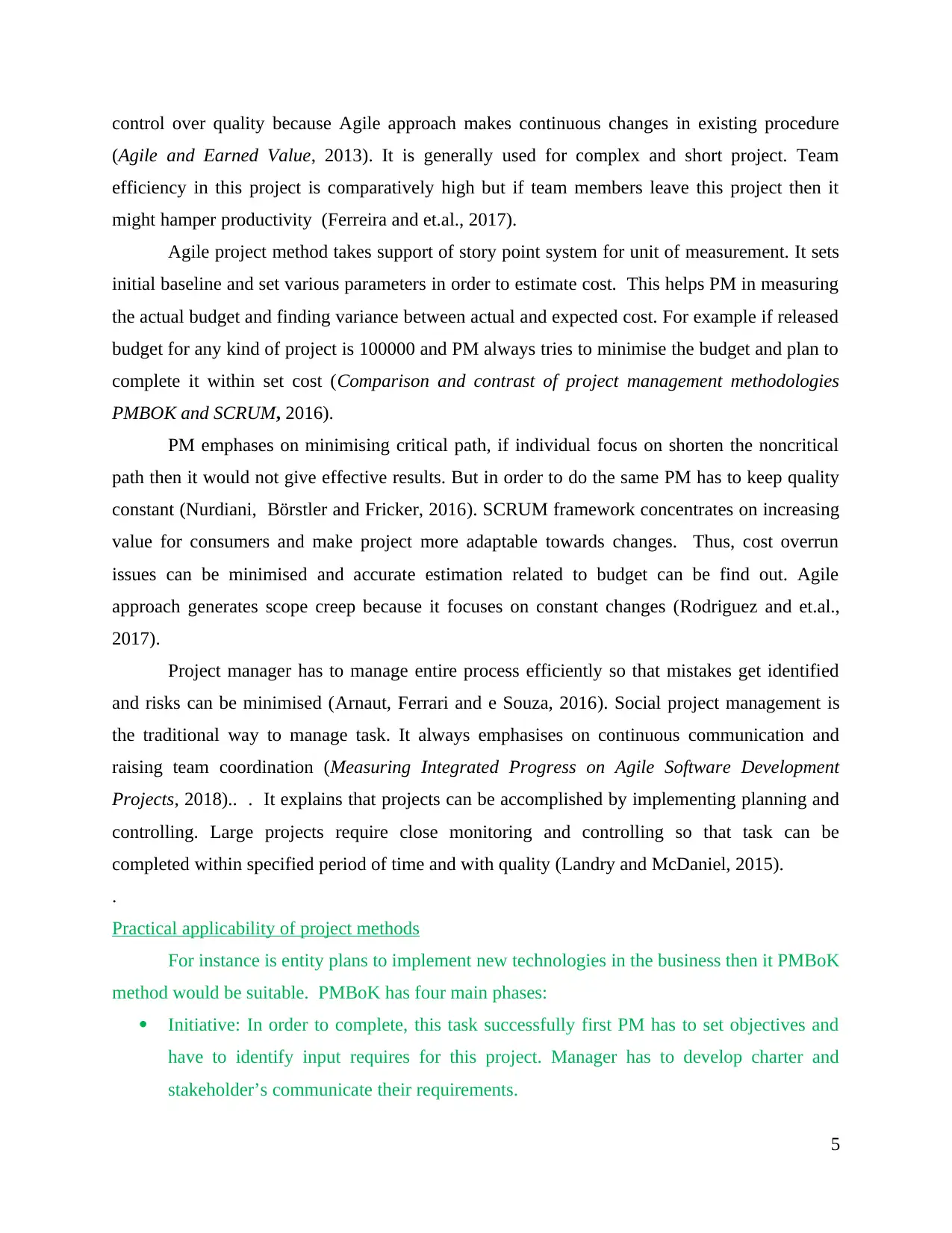
control over quality because Agile approach makes continuous changes in existing procedure
(Agile and Earned Value, 2013). It is generally used for complex and short project. Team
efficiency in this project is comparatively high but if team members leave this project then it
might hamper productivity (Ferreira and et.al., 2017).
Agile project method takes support of story point system for unit of measurement. It sets
initial baseline and set various parameters in order to estimate cost. This helps PM in measuring
the actual budget and finding variance between actual and expected cost. For example if released
budget for any kind of project is 100000 and PM always tries to minimise the budget and plan to
complete it within set cost (Comparison and contrast of project management methodologies
PMBOK and SCRUM, 2016).
PM emphases on minimising critical path, if individual focus on shorten the noncritical
path then it would not give effective results. But in order to do the same PM has to keep quality
constant (Nurdiani, Börstler and Fricker, 2016). SCRUM framework concentrates on increasing
value for consumers and make project more adaptable towards changes. Thus, cost overrun
issues can be minimised and accurate estimation related to budget can be find out. Agile
approach generates scope creep because it focuses on constant changes (Rodriguez and et.al.,
2017).
Project manager has to manage entire process efficiently so that mistakes get identified
and risks can be minimised (Arnaut, Ferrari and e Souza, 2016). Social project management is
the traditional way to manage task. It always emphasises on continuous communication and
raising team coordination (Measuring Integrated Progress on Agile Software Development
Projects, 2018).. . It explains that projects can be accomplished by implementing planning and
controlling. Large projects require close monitoring and controlling so that task can be
completed within specified period of time and with quality (Landry and McDaniel, 2015).
.
Practical applicability of project methods
For instance is entity plans to implement new technologies in the business then it PMBoK
method would be suitable. PMBoK has four main phases:
Initiative: In order to complete, this task successfully first PM has to set objectives and
have to identify input requires for this project. Manager has to develop charter and
stakeholder’s communicate their requirements.
5
(Agile and Earned Value, 2013). It is generally used for complex and short project. Team
efficiency in this project is comparatively high but if team members leave this project then it
might hamper productivity (Ferreira and et.al., 2017).
Agile project method takes support of story point system for unit of measurement. It sets
initial baseline and set various parameters in order to estimate cost. This helps PM in measuring
the actual budget and finding variance between actual and expected cost. For example if released
budget for any kind of project is 100000 and PM always tries to minimise the budget and plan to
complete it within set cost (Comparison and contrast of project management methodologies
PMBOK and SCRUM, 2016).
PM emphases on minimising critical path, if individual focus on shorten the noncritical
path then it would not give effective results. But in order to do the same PM has to keep quality
constant (Nurdiani, Börstler and Fricker, 2016). SCRUM framework concentrates on increasing
value for consumers and make project more adaptable towards changes. Thus, cost overrun
issues can be minimised and accurate estimation related to budget can be find out. Agile
approach generates scope creep because it focuses on constant changes (Rodriguez and et.al.,
2017).
Project manager has to manage entire process efficiently so that mistakes get identified
and risks can be minimised (Arnaut, Ferrari and e Souza, 2016). Social project management is
the traditional way to manage task. It always emphasises on continuous communication and
raising team coordination (Measuring Integrated Progress on Agile Software Development
Projects, 2018).. . It explains that projects can be accomplished by implementing planning and
controlling. Large projects require close monitoring and controlling so that task can be
completed within specified period of time and with quality (Landry and McDaniel, 2015).
.
Practical applicability of project methods
For instance is entity plans to implement new technologies in the business then it PMBoK
method would be suitable. PMBoK has four main phases:
Initiative: In order to complete, this task successfully first PM has to set objectives and
have to identify input requires for this project. Manager has to develop charter and
stakeholder’s communicate their requirements.
5
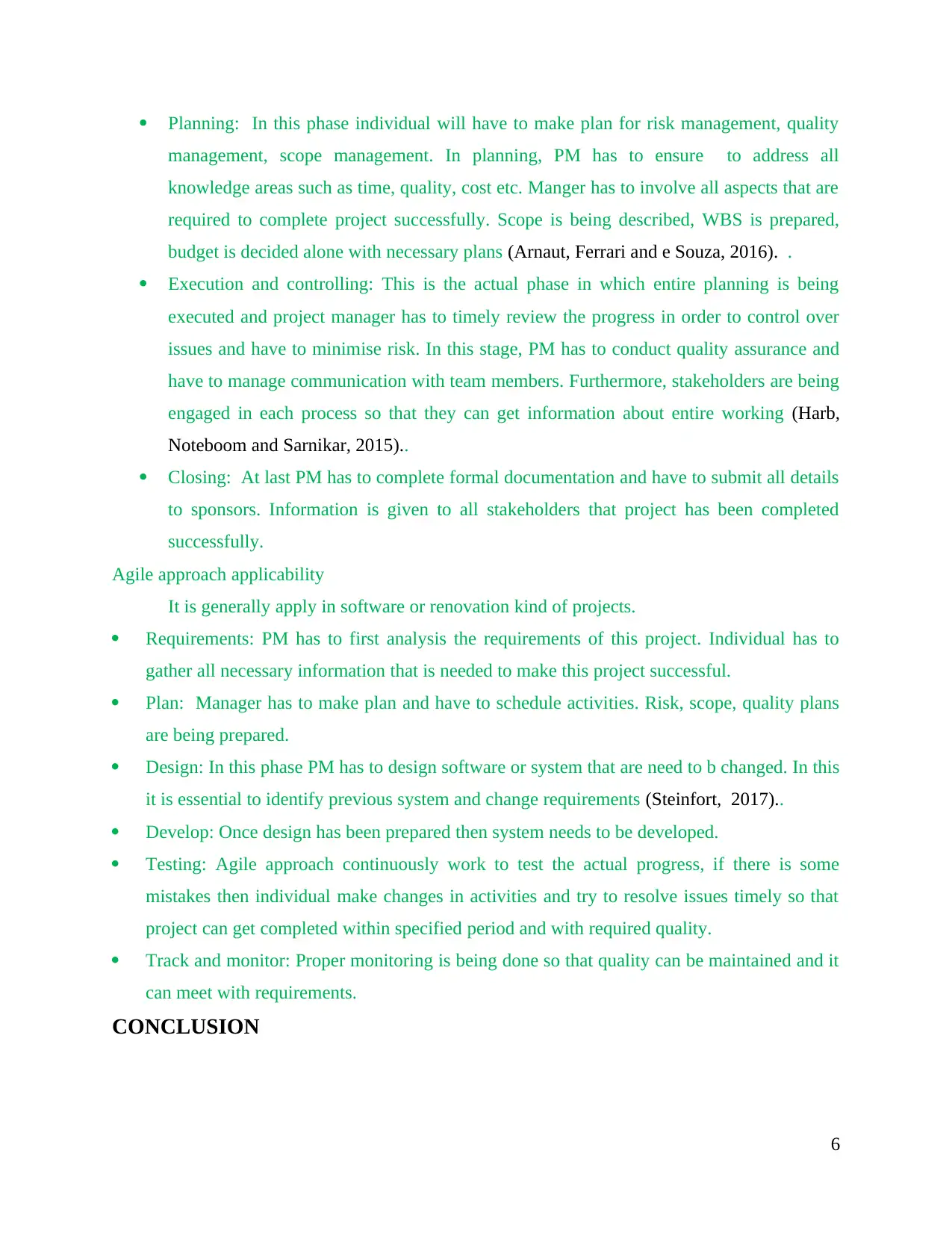
Planning: In this phase individual will have to make plan for risk management, quality
management, scope management. In planning, PM has to ensure to address all
knowledge areas such as time, quality, cost etc. Manger has to involve all aspects that are
required to complete project successfully. Scope is being described, WBS is prepared,
budget is decided alone with necessary plans (Arnaut, Ferrari and e Souza, 2016). .
Execution and controlling: This is the actual phase in which entire planning is being
executed and project manager has to timely review the progress in order to control over
issues and have to minimise risk. In this stage, PM has to conduct quality assurance and
have to manage communication with team members. Furthermore, stakeholders are being
engaged in each process so that they can get information about entire working (Harb,
Noteboom and Sarnikar, 2015)..
Closing: At last PM has to complete formal documentation and have to submit all details
to sponsors. Information is given to all stakeholders that project has been completed
successfully.
Agile approach applicability
It is generally apply in software or renovation kind of projects.
Requirements: PM has to first analysis the requirements of this project. Individual has to
gather all necessary information that is needed to make this project successful.
Plan: Manager has to make plan and have to schedule activities. Risk, scope, quality plans
are being prepared.
Design: In this phase PM has to design software or system that are need to b changed. In this
it is essential to identify previous system and change requirements (Steinfort, 2017)..
Develop: Once design has been prepared then system needs to be developed.
Testing: Agile approach continuously work to test the actual progress, if there is some
mistakes then individual make changes in activities and try to resolve issues timely so that
project can get completed within specified period and with required quality.
Track and monitor: Proper monitoring is being done so that quality can be maintained and it
can meet with requirements.
CONCLUSION
6
management, scope management. In planning, PM has to ensure to address all
knowledge areas such as time, quality, cost etc. Manger has to involve all aspects that are
required to complete project successfully. Scope is being described, WBS is prepared,
budget is decided alone with necessary plans (Arnaut, Ferrari and e Souza, 2016). .
Execution and controlling: This is the actual phase in which entire planning is being
executed and project manager has to timely review the progress in order to control over
issues and have to minimise risk. In this stage, PM has to conduct quality assurance and
have to manage communication with team members. Furthermore, stakeholders are being
engaged in each process so that they can get information about entire working (Harb,
Noteboom and Sarnikar, 2015)..
Closing: At last PM has to complete formal documentation and have to submit all details
to sponsors. Information is given to all stakeholders that project has been completed
successfully.
Agile approach applicability
It is generally apply in software or renovation kind of projects.
Requirements: PM has to first analysis the requirements of this project. Individual has to
gather all necessary information that is needed to make this project successful.
Plan: Manager has to make plan and have to schedule activities. Risk, scope, quality plans
are being prepared.
Design: In this phase PM has to design software or system that are need to b changed. In this
it is essential to identify previous system and change requirements (Steinfort, 2017)..
Develop: Once design has been prepared then system needs to be developed.
Testing: Agile approach continuously work to test the actual progress, if there is some
mistakes then individual make changes in activities and try to resolve issues timely so that
project can get completed within specified period and with required quality.
Track and monitor: Proper monitoring is being done so that quality can be maintained and it
can meet with requirements.
CONCLUSION
6
⊘ This is a preview!⊘
Do you want full access?
Subscribe today to unlock all pages.

Trusted by 1+ million students worldwide

From the above study, it can be concluded that Agile methods are unable to describe facets
that are require to complete a project successfully. Agile framework concentrates on managing
requirements in scope management and it is unable to address risk completely. Whereas PMBoK
method is able to address all risk by conducting risk, assessment plan. Furthermore, it is able to
manage time and complete the proposal within specified period.
7
that are require to complete a project successfully. Agile framework concentrates on managing
requirements in scope management and it is unable to address risk completely. Whereas PMBoK
method is able to address all risk by conducting risk, assessment plan. Furthermore, it is able to
manage time and complete the proposal within specified period.
7
Paraphrase This Document
Need a fresh take? Get an instant paraphrase of this document with our AI Paraphraser
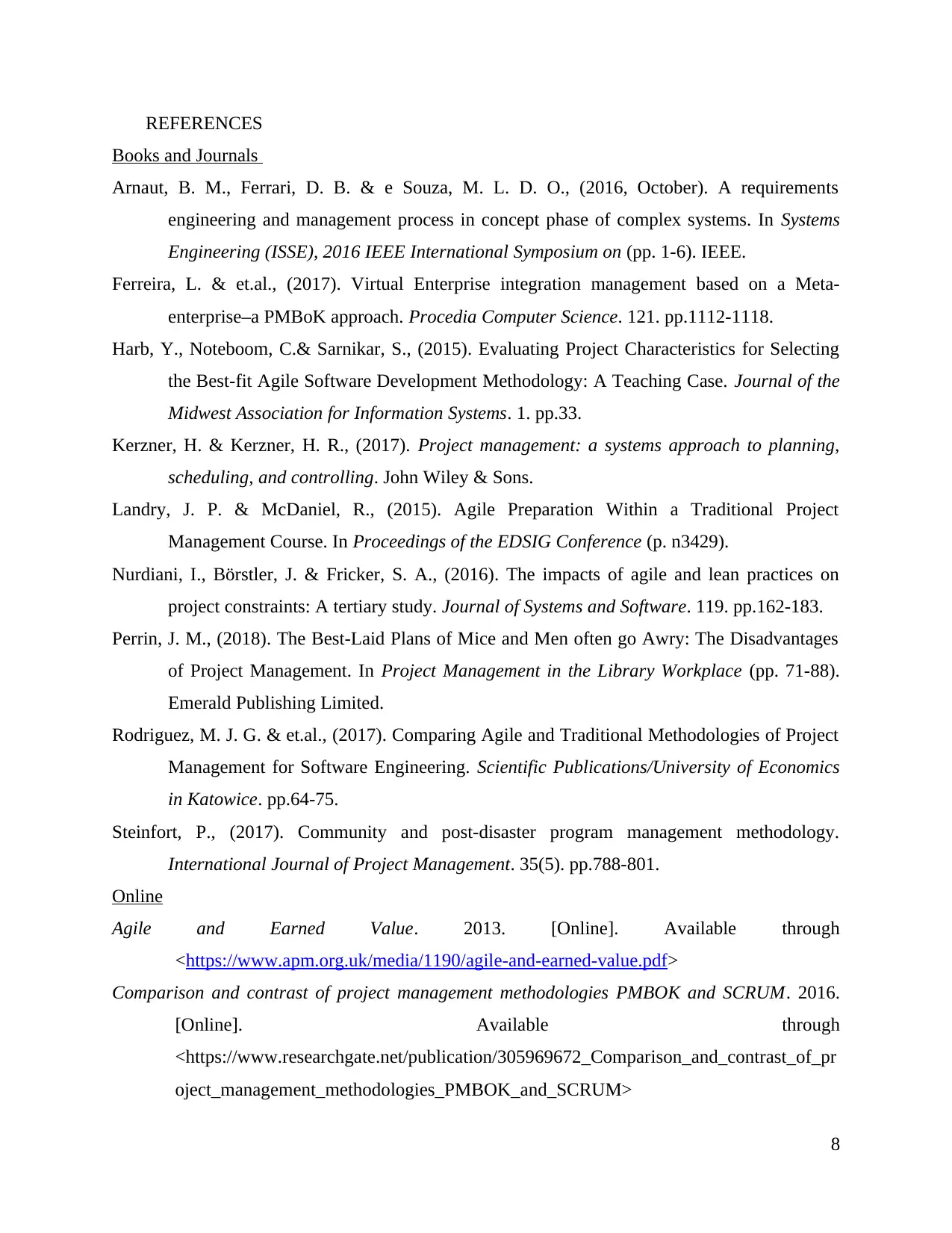
REFERENCES
Books and Journals
Arnaut, B. M., Ferrari, D. B. & e Souza, M. L. D. O., (2016, October). A requirements
engineering and management process in concept phase of complex systems. In Systems
Engineering (ISSE), 2016 IEEE International Symposium on (pp. 1-6). IEEE.
Ferreira, L. & et.al., (2017). Virtual Enterprise integration management based on a Meta-
enterprise–a PMBoK approach. Procedia Computer Science. 121. pp.1112-1118.
Harb, Y., Noteboom, C.& Sarnikar, S., (2015). Evaluating Project Characteristics for Selecting
the Best-fit Agile Software Development Methodology: A Teaching Case. Journal of the
Midwest Association for Information Systems. 1. pp.33.
Kerzner, H. & Kerzner, H. R., (2017). Project management: a systems approach to planning,
scheduling, and controlling. John Wiley & Sons.
Landry, J. P. & McDaniel, R., (2015). Agile Preparation Within a Traditional Project
Management Course. In Proceedings of the EDSIG Conference (p. n3429).
Nurdiani, I., Börstler, J. & Fricker, S. A., (2016). The impacts of agile and lean practices on
project constraints: A tertiary study. Journal of Systems and Software. 119. pp.162-183.
Perrin, J. M., (2018). The Best-Laid Plans of Mice and Men often go Awry: The Disadvantages
of Project Management. In Project Management in the Library Workplace (pp. 71-88).
Emerald Publishing Limited.
Rodriguez, M. J. G. & et.al., (2017). Comparing Agile and Traditional Methodologies of Project
Management for Software Engineering. Scientific Publications/University of Economics
in Katowice. pp.64-75.
Steinfort, P., (2017). Community and post-disaster program management methodology.
International Journal of Project Management. 35(5). pp.788-801.
Online
Agile and Earned Value. 2013. [Online]. Available through
<https://www.apm.org.uk/media/1190/agile-and-earned-value.pdf>
Comparison and contrast of project management methodologies PMBOK and SCRUM. 2016.
[Online]. Available through
<https://www.researchgate.net/publication/305969672_Comparison_and_contrast_of_pr
oject_management_methodologies_PMBOK_and_SCRUM>
8
Books and Journals
Arnaut, B. M., Ferrari, D. B. & e Souza, M. L. D. O., (2016, October). A requirements
engineering and management process in concept phase of complex systems. In Systems
Engineering (ISSE), 2016 IEEE International Symposium on (pp. 1-6). IEEE.
Ferreira, L. & et.al., (2017). Virtual Enterprise integration management based on a Meta-
enterprise–a PMBoK approach. Procedia Computer Science. 121. pp.1112-1118.
Harb, Y., Noteboom, C.& Sarnikar, S., (2015). Evaluating Project Characteristics for Selecting
the Best-fit Agile Software Development Methodology: A Teaching Case. Journal of the
Midwest Association for Information Systems. 1. pp.33.
Kerzner, H. & Kerzner, H. R., (2017). Project management: a systems approach to planning,
scheduling, and controlling. John Wiley & Sons.
Landry, J. P. & McDaniel, R., (2015). Agile Preparation Within a Traditional Project
Management Course. In Proceedings of the EDSIG Conference (p. n3429).
Nurdiani, I., Börstler, J. & Fricker, S. A., (2016). The impacts of agile and lean practices on
project constraints: A tertiary study. Journal of Systems and Software. 119. pp.162-183.
Perrin, J. M., (2018). The Best-Laid Plans of Mice and Men often go Awry: The Disadvantages
of Project Management. In Project Management in the Library Workplace (pp. 71-88).
Emerald Publishing Limited.
Rodriguez, M. J. G. & et.al., (2017). Comparing Agile and Traditional Methodologies of Project
Management for Software Engineering. Scientific Publications/University of Economics
in Katowice. pp.64-75.
Steinfort, P., (2017). Community and post-disaster program management methodology.
International Journal of Project Management. 35(5). pp.788-801.
Online
Agile and Earned Value. 2013. [Online]. Available through
<https://www.apm.org.uk/media/1190/agile-and-earned-value.pdf>
Comparison and contrast of project management methodologies PMBOK and SCRUM. 2016.
[Online]. Available through
<https://www.researchgate.net/publication/305969672_Comparison_and_contrast_of_pr
oject_management_methodologies_PMBOK_and_SCRUM>
8
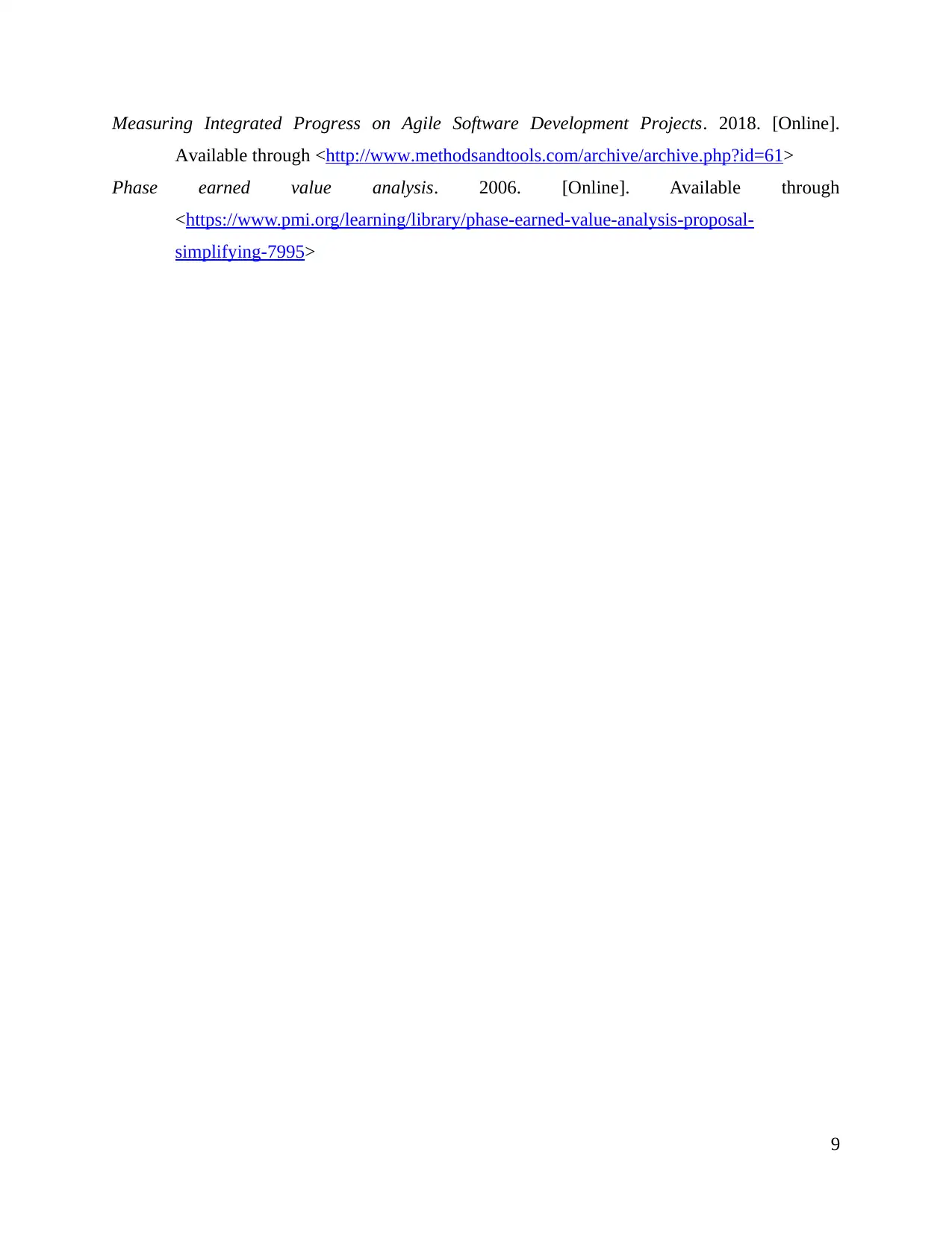
Measuring Integrated Progress on Agile Software Development Projects. 2018. [Online].
Available through <http://www.methodsandtools.com/archive/archive.php?id=61>
Phase earned value analysis. 2006. [Online]. Available through
<https://www.pmi.org/learning/library/phase-earned-value-analysis-proposal-
simplifying-7995>
9
Available through <http://www.methodsandtools.com/archive/archive.php?id=61>
Phase earned value analysis. 2006. [Online]. Available through
<https://www.pmi.org/learning/library/phase-earned-value-analysis-proposal-
simplifying-7995>
9
⊘ This is a preview!⊘
Do you want full access?
Subscribe today to unlock all pages.

Trusted by 1+ million students worldwide
1 out of 12
Related Documents
Your All-in-One AI-Powered Toolkit for Academic Success.
+13062052269
info@desklib.com
Available 24*7 on WhatsApp / Email
![[object Object]](/_next/static/media/star-bottom.7253800d.svg)
Unlock your academic potential
Copyright © 2020–2025 A2Z Services. All Rights Reserved. Developed and managed by ZUCOL.



